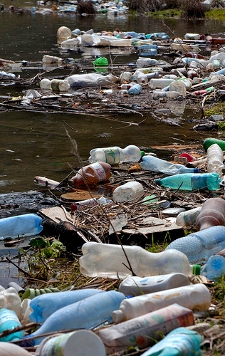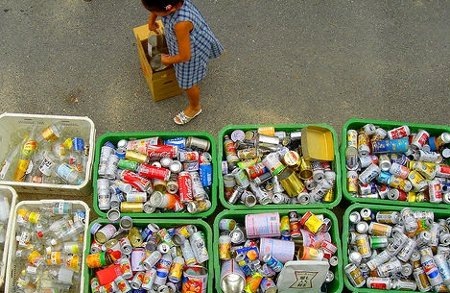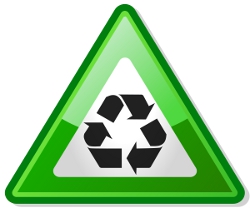Lesson: Trash Talkin’
 (Lesson courtesy of TeachEngineering)
(Lesson courtesy of TeachEngineering)
Grade Level: 4 (3-5). Group Size: 4. Expendable Cost Per Group: US$ 5. Time Required: 60 minutes
OVERVIEW
In this activity, students collect, categorize, weigh and analyze classroom solid waste. The class collects waste for a week, and then student groups spend a day sorting and analyzing the garbage with respect to recyclable and non-recyclable items. Students will discuss ways that engineers have helped to reduce solid waste.
Excessive product packaging materials add to the solid-waste (garbage) problem. Packaging engineers use smaller amounts of materials, and find more creative and efficient ways to safely package consumer products. Engineers determine materials (paper, paperboard, plastics, glass, metal and wood) and if protective packaging is needed, using environmentally friendly and recyclable materials when possible.
EDUCATIONAL STANDARDS
Colorado Math (Grades 0 – 4) [2005]
4.1.1. demonstrate meanings for whole numbers, and commonly used fractions and decimals (for example, 1/3, 3/4, 0.5, 0.75), and represent equivalent forms of the same number through the use of physical models, drawings, calculators, and computers.
4.3.1. construct, read, and interpret displays of data including tables, charts, pictographs, and bar graphs.
4.5.1. know, use, describe, and estimate measures of length, perimeter, capacity, weight, time, and temperature.
4.6.1. demonstrate conceptual meanings for the four basic arithmetic operations of addition, subtraction, multiplication, and division.
Colorado Science (Grades 0 – 12) [1995]
Standard 3.1: Students know and understand the characteristics of living things, the diversity of life, and how living things interact with each other and with their environment.
Standard 5: Students know and understand interrelationships among science, technology, and human activity and how they can affect the world.
Standard 1: Students understand the processes of scientific investigation and design, conduct, communicate about, and evaluate such investigations.
Standard 6: Students understand that science involves a particular way of knowing and understand common connections among scientific disciplines.
For other state and national standards, please see the TeachEngineering lesson plan.
LEARNING OBJECTIVES
After this activity, students should be able to:
- Make predictions on the types of trash that the class will collect for a week;
- Sort trash into categories (food, paper, plastic, metal, glass and misc.) and sub-categories (re-useable, recyclable and non-recyclable);
- Calculate the total mass of a group of items;
- Analyze their results using percents and graphing in relation to mass and amount;
- Explain the cause-effect relationship on the environment of accumulating solid waste;
- Describe the attitudes on solid waste in developed and undeveloped countries;
- Suggest ways to reduce the amount of solid waste that goes to a landfill;
- Understand and explain the role of engineers in solid waste management; and
- Write to synthesize and analyze new information and communicate understanding.
MATERIALS LIST
Each group should have:
- Classroom trash (1 week’s worth)
- Multiple trash cans/bins (for sorting different types of trash: recyclable and non-recyclable paper, recyclable plastic and metals and glass, and miscellaneous food waste.
- 3 plastic garbage bags (grocery sacks will suffice)
- Bathroom scale (groups may share)
- Rubber/latex gloves (1 pair per student)
- 4 copies of the Let’s Talk Trash Worksheet (1 per student)
ATTACHMENTS
INTRODUCTION/MOTIVATION
Per capita, the U.S. is one of the worst trash-makers in the world. Americans use a lot of disposable products and products with abundant — and wasteful — packaging. For example, 1.6 billion writing pens go into the garbage and 7 million automobiles are junked in the U.S. each year.
Wealthy countries, in general, produce more trash than other countries because the people in those countries can “afford” to consume more products. Oftentimes, developed countries try to export their trash to poorer countries in exchange for money to store their trash. Those poorer countries often take the waste because they need the money, even though they actually have no safe way to dispose of the waste.
Engineers continuously try to develop methods for decreasing the amount of packaging needed for products and to create recycled packaging materials from items that are thrown away, such as plastics. Consumers need to help the engineers out by knowing how to sort the items in garbage that can be recycled and re-used. Once the recyclable items have been sorted out, consumers need to make sure they get to the proper recycling facility, either by being picked up by a recycling service or by being dropped off at a recycling center. Consumers can also help engineers by producing less waste and re-using items, such as wrapping paper and plastic eating utensils. By helping engineers as they try to develop technologies for dealing with waste, we are also helping our communities from having to find places to store extra garbage.
Did you know?
- More than 1/3 (about 40%) of U.S. garbage is paper.
- About 1/3 of the items thrown into the garbage originally started out as packaging (most of which is unnecessary — it is just used to attract consumers’ attention so that they will buy the product).
- Americans throw away enough plastic bottles every year to circle the planet 4 times. Only 1/3 of the plastic bottles used are recycled.
VOCABULARY/DEFINITIONS
Reusable: An item that can be immediately used again, repaired and used again, or used in a new way.
Recyclable: An item that may be remade either as the same thing or as part of a different product (without recollecting and processing the initial natural resources).
Non-recyclable: An item that is neither reusable nor recyclable.
Trash: Items that are considered worthless, unnecessary, or offensive and that are most often thrown away. Usually, it is defined as dry material and excludes food waste (garbage) and ashes.
Garbage: Spoiled or waste food that is thrown away.
PROCEDURE
Before the Lesson
- Gather enough trash cans/bins to store the classroom trash for a week.
- Make large, easily readable labels for each trash container.
- Discuss the plan with the school custodian or a substitute to ensure that the trash stays in the classroom all week (do not skip this step: a well-intentioned custodian or substitute may throw away the activity materials thinking they are doing a favor!).
- The trash collection period should run for 5 full class days. Day 6 should be for the lab portion of the project.
- Make a large class data chart similar to the data collection chart on the Let’s Talk Trash Worksheet.
Before Day 1 of Trash Collection
• Describe the project to the class. Discuss the different type of trash that will be collected and how it will be collected. (Note: collect only trash from the classroom. Do not ask the students to bring their trash back from the lunchroom or from home.) Show students where the different labeled trash containers will be located in the classroom for the week. Demonstrate that plastic goes in the container labeled “plastic,” paper in the container labeled “paper,” etc.
• Collect trash for 5 full school days.
Day 6: The Lab Day
1. On the 6th day, divide the students into groups of 4.
2. Distribute the Let’s Talk Trash Worksheet to each student.
2. Ask students to predict how much trash (total mass) the class generated during the week and predict the amount of trash in each of the categories (e.g., food, paper, plastic, etc.).
3. Assign each group one portion of the trash as their lab materials. Distribute a pair of gloves to each student.
4. Distribute three trash bags to each group, and ask each group to sort their trash using the trash bags. Remind them to wear their gloves! They should sort their trash into three groups: re- recyclable, non-recyclable and reusable. Do not sort any food waste!
5. Ask each group to find the mass of each pile of trash. Instruct them to record the mass data on the large class data sheet. Remind them to record their units (kg or lbs) on their own data table and to round to the nearest ½ unit (this will depend on the scale).
6. Ask each group to share their results with the class. All students should complete their data table at this time. Student teams can write their mass in the class data sheet on the board or overhead.
7. Ask students to complete the Analysis section of their worksheet. If there is not enough time, they can finish the graph for homework.
8. Have students work in their teams on the Discussion Questions portion of the worksheet. After they have finished, discuss answers as a class.
9. Using the Conclusions section of the worksheet, assign one student in the group to be the recorder. Then ask a student to toss out an idea. Next, another person in the group provides an idea that builds on the first. Go around the group in this fashion until all students have put in enough ideas to put together a design. When they are done, have them share their ideas with the class.
SAFETY ISSUES
Have students wear gloves when sorting trash. Remind students that the plastic bags should not be played with (i.e., put over their own or others’ heads) and should only be used for sorting the trash. Be sure glass items are not broken and that metal items do not have sharp edges. Be sure to seal the food trash bag each day in order to prevent health hazards. Another option is to weigh the food trash each day and keep a running record of it. Be sure all containers are rinsed before being placed in the waste bins (especially food containers).
TROUBLESHOOTING TIPS
It may be necessary to review how to calculate percents and/or how to create pie charts. Save the recyclable and reusable materials for activities in later lessons.
ASSESSMENT
Pre-Activity Assessment
Prediction: Using the worksheet provided for the activity, ask students to predict how much trash (total mass) the class generated this week, and predict the amount of trash in each of the categories (e.g., food, paper, plastic, etc.).
Activity Embedded Assessment
Worksheet: Have students fill out the Analysis section of the Let’s Talk Trash Worksheet as they follow along with the activity
Pairs Check: Have students pair up within their teams and work on the discussion question portion of the worksheet. After students have finished, discuss answers as a class.
Pass the Buck: Assign one student in the group to be the recorder, and have students complete the Conclusion section of the worksheet. Have a student toss out an idea. Next, another person in the group provides an idea that builds on the first. Go around the group in this fashion until all students have put in enough ideas to put together a design. When they are done, have them share their ideas with the class.
Activity Extensions
• Create a school bulletin board to report your findings.
• Ask students to write a letter to the editor of the school newspaper, if applicable, describing the class findings and urging others to make changes in their “trash habits.”
• Challenge another class to reduce its solid waste by more than your class.
• Contact the local solid waste disposal company, and ask them to give you community percentages for each of the trash categories. Compare this information to your classroom results.
ACTIVITY SCALING
For 3rd grade, chose one or more of the following:
• Mass – ask the students to find the mass of each category of waste. Create a bar graph of the results. Discuss the results in terms of “less” and “more.”
• Pie Chart – using a pre-made pie chart, ask students to cut and paste pictures that represent each category on the appropriate slice on the chart. You could even have one large class chart (have each student paste a picture in each section or have different groups be responsible for different categories).
• Class Discussion – As a class, discuss some of the differences between reusable, recyclable and non-recyclable items. Use some examples from your trash bins to illustrate this.
For 4th grade, do the activity as-is.
For 5th grade, have students look at the fraction and decimal representations of the different categories in addition to the percentages.
REFERENCES
Glencoe Science: An Introduction to the Life, Earth and Physical Sciences, Student Edition, Blacklick, Ohio: Glencoe/McGraw-Hill, 2002.
Prentice Hall Science. Ecology Earth’s Natural Resources Activity Book, New Jersey: Prentice Hall, Inc., 1993.
Spurling Jennett, Pamela. Investigations in Science – Ecology, Westminster, CA: Creative Teaching Press, Inc., 1995.
CONTRIBUTORS
Amy Kolenbrander, Jessica Todd, Malinda Schaefer Zarske, Janet Yowell
The contents of this digital library curriculum were developed under a grant from the Fund for the Improvement of Postsecondary Education (FIPSE), U.S. Department of Education and National Science Foundation GK-12 grant no. 0226322. However, these contents do not necessarily represent the policies of the Department of Education or National Science Foundation, and you should not assume endorsement by the federal government.
Supporting Program: Integrated Teaching and Learning Program, College of Engineering, University of Colorado at Boulder
Copyright © 2005 by Regents of the University of Colorado
Filed under: Grades K-5, Lesson Plans
Tags: Environmental Engineering, Environmental science, Grades 3-5, Lesson Plan, Recycling, Waste management










